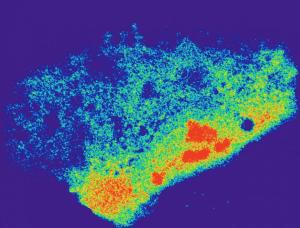
This image shows a cell carrying an RNA-targeted Cas9 system. (Image credit: David Nelles of the University of California, San Diego)
By modifying the CRISPR-Cas9 system, typically used for genetic editing, researchers are able to visually track the movement of RNA in living cells.
The researchers believe this could be used to study disease-related RNA processes. Many diseases are related to errors in RNA and RNA transcription, such as different cancers and autism.
In the future the researchers believe their work can support therapeutic approaches to correct disease-causing RNA behaviors.
Original research paper published in Cell on March 17, 2015.
Names and affiliations of selected authors

